Museum geek alert! Now that I’m working at the HDB hub, I have many opportunities to check out the HDB gallery. This gallery showcases the development of the Singapore public housing over the years and is open to the public.

(frankly, I probably wouldn’t have known of this place if it wasn’t for a fellow museum geek. And he doesn’t even work at HDB!)
With approximately 80 percent of the Singapore population living in flats, HDB has come a long way since forming in 1960. Today, HDB also plays a consultant role in housing issues to countries such as Hong Kong and those in the Middle East.
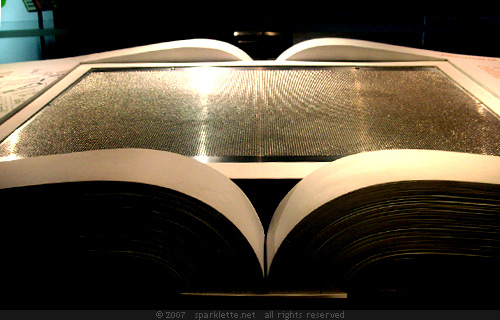
The first display that visitors see in the gallery is this pin model. It has a panel of metal pins placed upon a giant book.
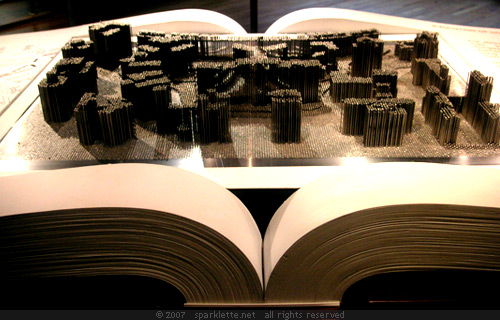
At the touch of a button, the book slowly lowers, leaving behind several “blocks” of pins in varying sizes and heights. They reveal the shapes and designs of HDB housing blocks. It actually looks pretty neat!

The colourful map shows the various housing estates in Singapore. Each estate lights up when you press the corresponding button on the input panels.

This “memory lane” passageway is lined with television screens on both sides. Beyond this, lies the main exhibit area where scenes of life back in the yesteryears are depicted.
From the early 1900s, people lived in crowded slums and squatter settlements with no proper sanitation, lighting or ventilation. Houses were built using attap leaves, old boxes and scrap metal.
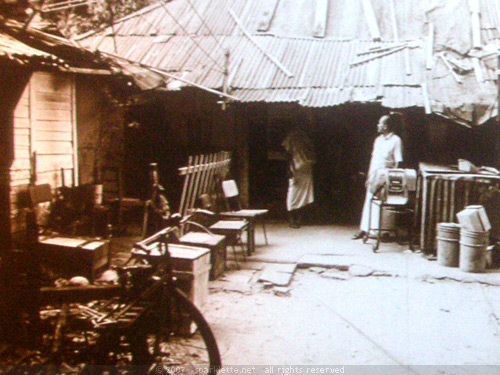
Several families had to share a communal kitchen that was often dirty. (at a recent trip to the Chinatown heritage centre, I was able to get a better look and feel of this, and of what life was like back then. For those who are interested, do ask me to blog about it later!)
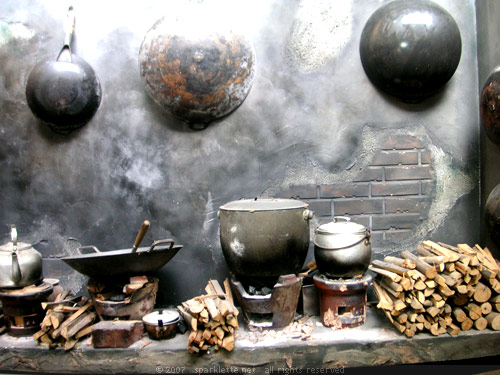
The pots and pans and the kitchen walls have been blackened from soot.

What a stark contrast to the Singapore of today! And it wasn’t even that long ago. Not only was such housing unsanitary, it also posed health and fire hazards.
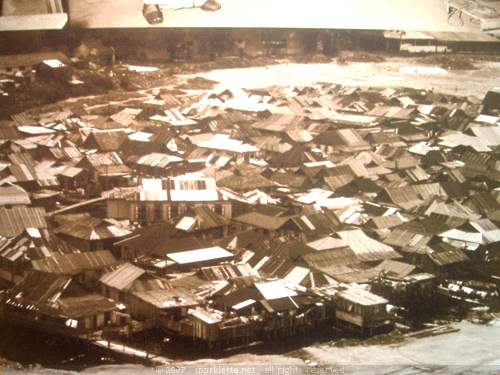
In 1960, HDB was formed to address the critical housing shortage. I’m sure many of you Singaporeans have heard about the infamous bukit ho swee fire that broke out in 1961. (I have heard a certain conspiracy theory about this but I shan’t state it here, for obvious reasons.)
That massive fire rendered 16,000 slum dwellers homeless overnight. Over a period of just 8 months, HDB managed to build sufficient emergency flats to house these people.

Look at these old flats in Tiong Bahru. They are still around today!

Moving on to modern times, this is a model of the eco-precinct, treetops @ punggol. As its name suggests, this is an eco-friendly precinct that will incorporate a range of green technologies and innovations for effective energy, water and waste management. We’re talking solar panels, centralised recyclable refuse chutes and a rainwater collection system.
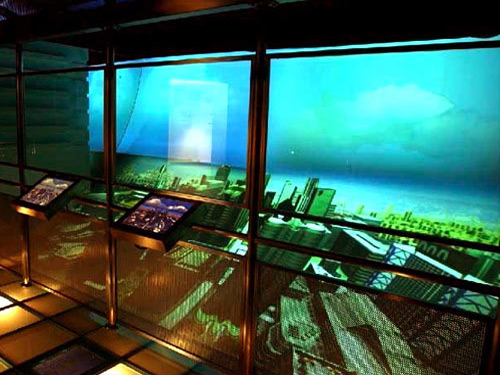
The skybridge above simulates the view from 50 storeys above the ground, with skyscrapers, moving vehicles, and a sky that changes according to the time of the day. The concept was good, but the CGI was pretty bad.
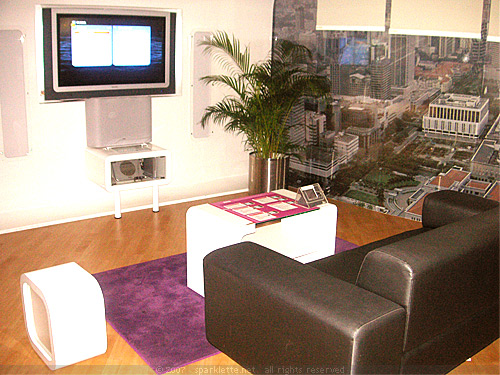
In the near future, technology would be very much integrated into homes. What you see above is a working model of a living room in an e-home. Visitors get to play around with the electronic devices.
For example, music, movies and pictures can be transferred wirelessly from the study room computer to the television set in the living room. Lights can be turned on and off, and window blinds can be rolled up or down all from one central device.
And that’s not all. Say you go out but you forget to turn off the lights at home. You can simply go online and have remote access to turn off the lights from wherever you are. All you would need is an internet connection!

Pretty cool! I hope this becomes a reality soon!
This is a rather small gallery. For those of you who happen to pass by the HDB hub, you may want to check it out. It would give you a better idea of the history behind public housing in Singapore, and what lies in store.
HDB Hub
480 Toa Payoh Lorong 6
Basement 1 Singapore 310480 [map]
Opening hours: 8:30am – 5pm (Monday to Friday)
Admission: Free
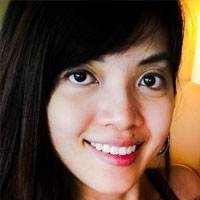
Apr 11, 2007
15
wow veron, thats such an awesome place… got to go and see it for myself one day! :)
Never knew HDB hub actually have such informative displays =)
Apr 12, 2007
3472
I never knew either, until someone told me right before I started work at the hub! Looks like they (or we?) are not doing a great job at promoting the gallery.
Apr 12, 2007
34
Wat a waste of money…. :P
Apr 12, 2007
3472
What?
Apr 12, 2007
14
funnily, i’ve been there before. and even more ironically, my visit there only made me more resolute never to stay in a hdb flat. eh, so i don’t know if it’s a good idea to market that place out to more visitors…
Apr 12, 2007
3472
I’m glad 80% of the population disagrees :)
Apr 12, 2007
9
HDB flats are definitely of very high standards in S’pore. Actually, in France we also have the equivalent that are called HLM (Habitation à loyer modéré ~ Housing for a moderate rent) and are state-owned, but they are usually either in areas where no one wants to live, or very difficult to get, cause very scarce (you need to wait for decades to get a flat).
Unlike most of my fellow non S’porean friends in S’pore, I decided to go for HDB rather than condo, and I’m 99% happy with that (public transportation is much more accessible, living among the locals, lower rent….). Well, sometimes I regret not having a pool though, even if most of the time its too cloudy to sunbathe :-)
Apr 12, 2007
43
Who would have thought that such a museum exist? I would drop by to take a look if I’m at the HDB hub (if I’m lucky to get a queue no for my recent ballot!). I love the Tiong Bahru flats that are under the conservation scheme; there is a very nostalgic feel to them. And with the new enviro-friendly and smart flats coming up, it seems that HDB is constantly improving itself. My only grouse..why are the flats getting tinier and tinier?
Apr 12, 2007
182
Hi Veron, I went to the gallery once. Guess what? There was no public announcements when the gallery was to be closed, and somehow, I ended up locked all alone in the gallery. So just a note of caution for your readers that they should read the opening hours and take note of it before entering the gallery.
Thank goodness, I was able to attract the attention of a passerby who then went to get the security guard to unlock the door.
The gallery is pretty cool. I quite like it. :)
Apr 13, 2007
3472
Mai: Pools are overrated! (But that’s probably because I can’t swim.) Just out of curiosity, are you Vietnamese or French?
Joyz: Guess what? I pass by those Tiong Bahru flats all the time! They look old alright, but I didn’t expect them to be among the oldest flats in Singapore!
py: There doesn’t appear to be any staff manning the gallery. Getting stuck in there alone must have been a little creepy. But luckily there is a part of the gallery that is fully visible to the Coffee Bean patrons at level one. Still, there should have been an announcement when it’s nearing closing hours!
Apr 13, 2007
72
Nice post and set of photos. You should submit to yesterday.sg as a post too (or maybe its up already?)
I live in a HDB flat and I love it here at my estate which is a mature one with lots of greenery and a splendid view. Honestly, things are so much more convenient here compared to living in condominiums or private homes where you have to travel much further to get your daily necessities.
Apr 13, 2007
3472
I have already submitted a post to yesterday.sg. Hope it gets published soon!
Apr 13, 2007
9
Veron : I’m definitely French (never lived anywhere else than France and 6 months in S’pore in my whole life :-P ), but my parents came from Vietnam. I find it very strange that people often ask for “races” in S’pore. It is quite a taboo in France to talk about it. I actually don’t mind, as long as people don’t try to categorize you based on that.
Joyz : I would ask the same question. Why are the flats so small ???? Maybe they should build higher buildings to fit more flats in ^^
Apr 13, 2007
3472
The only reason why people in Singapore see no problem in asking about races is because race is not an issue. We are a multi-racial society. Most of the time when this question is raised, it is purely out of curiosity. I myself get asked this question all the time because some people find it hard to believe that I’m pure Chinese. (I have coloured hair and natural light brown eyes.) I don’t get offended, nor do I see any reason to be. See? It is really not a big deal, and certainly not taboo.
Apr 13, 2007
43
Mai: The HDB flats are definitely increasing in height. In the past, the norm was 12 storeys…now its not surprising to see 50 storeys flats. But the sq foot has reduced tremendously. The rooms are so small, you can only fit in a single bed and a wardrobe and that’s it! We are really looking more and more like HK…the lack of space is killing us. =(
Apr 14, 2007
9
Veron: In think that the matter is slightly different in France, since the majority of people is obviously caucasian, and there is a tendency to discriminate against other minorities (I think of pple coming from North Africa especially). So being asked about your origin, is a risk of being discriminated against.
In S’pore, since the majority of pple are Chinese related, it is not such a big deal being asked about it. But when I was in S’pore I heard quite a lot of prejudices against Malay related people for example, or foreign workers and maids. I guess no society is perfect. And S’pore is not a bad place to be :-) …. as long as they don’t make HDB flats any tinier lol
Apr 14, 2007
3472
To be honest, people who are part of the majority race in a country would not feel or notice any form of racial discrimination. If it wasn’t for what I had heard from the non-Chinese (as well as the less-than-pleasant remarks that I had heard from the Chinese), I probably wouldn’t be aware that there is some inherent form of prejudice against them, including Singaporean Malays and Indians. Furthermore, the way in which we regard foreign maids and workers is embarrassing. What you said is true: No society is perfect.
On a lighter note… To foster racial cohesion, HDB has a specific quota pertaining to each of the three main races in each block of flats. I wonder if people are aware of this.
Apr 14, 2007
9
Thanks a lot for the answer !
But I was wondering, how does HDB manage with its quota when there are mixed couples, or mixed couples that already had mixed parents ??? :-P
Apr 14, 2007
5
Veron, you are right. There is a certain quota (chinese, malays and indians). You cannot have a neighbourhood of all chinese, or all malays. The concept of HDB is to foster inter-racial harmony. That’s why you will find community centres, schools and other amenitites located within the neighbourhood. As far as mixed couples are concerned, I believe the ratio of mixed couples to chinese, malays are not that high. I guess HDB would probably have worked out a certain weightage to allocate flats to couples of mixed marriages. Btw, your dream home of motorised curtains, scene control lighting with just 1 button, internet access to control and monitor your home is possible today. I am in such an industry and feel free to find out more if you are interested…..haha…. LOL
Apr 17, 2007
3472
Very exciting. I’m intrigued!